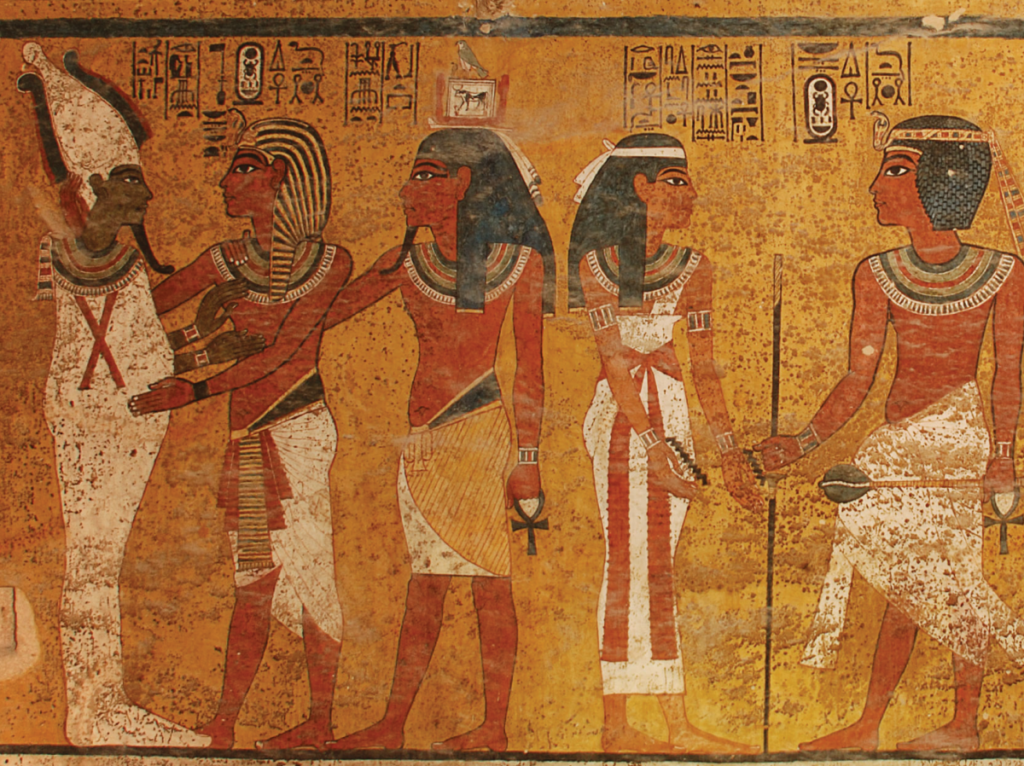While history is a peek into the culture and norms of times past, it also helps us understand where current-day trends and norms originated.
For example, the Ancient Egyptians have often been called one of the most innovative civilizations.
From their pyramids to religious traditions, historians and scientists have been fascinated for centuries by their practices.
One cultural norm that has had a lasting impact and continues to be a source of fascination is how men and women in ancient Egypt wore makeup.
This beauty ritual was not just in women; men, as early as 4000 B.C., adorned heavy makeup like eyeliner and painted eyebrows.
But why did they wear makeup? And how did they develop these products without today’s modern technology?

The Norms of Male Makeup
Based on the writings, artwork, and artifacts discovered, the ancient Egyptians cared greatly about their physical appearance.
From dying their hair to painting their nails, many of today’s beauty standards were practiced centuries ago by both men and women in ancient Egypt.
But unlike many of today’s beauty products, the Ancient Egyptians used the resources from the natural world around them to create their makeup.
Substances like malachite, kohl (more commonly known as galena), ochre, and henna were commonly used to add color to their makeup, while animal fats acted as an emulsifier for the ingredients.
While galena or kohl was used to paint the eyes or eyebrows black, malachite or copper could be used to give a green tint to the eyelids.
These materials were applied using sticks, ivory, or wood. However, it wasn’t only men of a high status that wore makeup — it was popular across classes for various reasons.
The difference between upper and lower-class Egyptian makeup was in the intricate makeup storage and containers that royalty used to hold their materials.
Wealthy Egyptians would have makeup boxes built out of ivory and carved wood, while lower-class citizens would use small jars, pots, and containers to hold their makeup creations.
Lips
Both men and women in ancient Egypt choose to accentuate their lips through the use of red ochre.
The color of lipstick could vary from red, black, orange, or magenta. But lipstick wasn’t just another beauty ritual — the color of an individual’s lips could also indicate their status.
Archaeologists have discovered burial tombs of royalty containing one or more pots containing lipstick materials.
Eyes
In Ancient Egyptian paintings, men of nobility are depicted in paintings wearing dark kohl around their eyes.
There were several purposes for this male eyeliner, but it ultimately gave a dramatic appearance in pictures and historical artifacts found from this time period.
Male eyeliner was common no matter an individual’s status in society.
Nails
Upper-class men in ancient Egyptian also made sure to take care of their nails, with many having personal manicurists.
Nail polish was made during this time period by using a henna mixture to create a dye for the nails.
Aside from the color, even the shape or length of nails could indicate an individual status in society.
Protection of the gods
The Egyptians believed that everything they did should be to please the gods. Many of their beauty rituals — both while they were alive and after their death in their preservation — were done to ensure they looked attractive.
Given how they idolized their gods, it is no surprise that their gods were another source of inspiration for the type of makeup worn by Ancient Egyptian men.
The sun god, Horus, often depicted as a falcon, had facial markings that resembled the makeup traditions of the time.
The dark eyeliner gives the eyes a bird-like appearance mimicking that of Horus. Ra, the sun god, is another ancient God that people believed would grant them protection if they wore makeup.
By looking like these gods and doing everything in their power to please them, the ancient Egyptians believed they would be granted similar powers and protection.
Protection from the elements
The most populous of Ancient Egyptian cities were settled along the Nile River. While fertile and lush, these conditions also presented harsh natural elements like the scorching sun, flies, and insects.
This, coupled with the extreme heat in Egypt, drove people to utilize makeup to solve their climate-induced problems.
Eyeliner, in particular, was used as a source of protection from these natural elements.
Similar to how athletes paint their faces black to protect from the sun’s glare, the kohl around Egyptian’s eyes was also helpful in deflecting the sun’s harsh rays.
This practice of painting black around the eyes was common across class groups and genders.
They also believed that their makeup offered “magical” healing powers. This was later proven to be true. By adding kohl around the eye, Ancient Egyptians thought they would be safe from infections and also helped repel the flies.
While at the time it was unproven, scientists have confirmed that the kohl used by Ancient Egyptians actually did prevent eye infections, thanks to the lead found in many of the makeup products they created.
While lead is toxic to the body, it also helps boost nitric oxide, which helps the immune system.
In the Afterlife
The ancient Egyptians believed that once they died, their soul would go to live another life in the spiritual world.
Since they believed entry into the afterlife was not guaranteed, they took great lengths to prepare both physically and spiritually for this impending journey.
Makeup and cosmetics have been uncovered in the burial chambers of higher-ranking Queens and Kings, indicating that they were concerned about how their physical appearance would translate into an afterlife.
Impact Today
From football players putting on eye black to drawing a cat-eye-style eyeliner, the trends in beauty today are uniquely similar to those of the Egyptians of centuries ago.
While men are less likely to wear makeup today, there’s no denying that the ancient Egyptian practices still impact today’s beauty and fashion norms.

